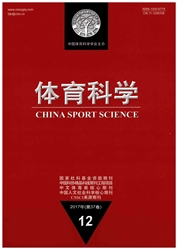

 中文摘要:
中文摘要:
目的:以运动预适应(EP)诱导心肌保护效应为研究基础,以心脏分子标志物NT—proBNP为研究核心,联合应用血清NT—proBNP与血清clhI和心肌HBFP染色,综合评价EP对力竭运动心肌的保护效应;方法:SD大鼠100只,随机分为对照组(C组)、力竭组(EE组)、运动预适应组(EP组)和运动预适应+力竭组(EP+EE组)。采用一次间歇性大强度跑台运动建立EP模型,力竭跑台运动建立急性心肌损伤模型。用ELIsA法检测血清NT—proBNP浓度,CLIA法检测血清cTnI浓度,HBFP染色法观察心肌缺血缺氧状况;结果:与C组比较,EE组血清NT—proBNP浓度显著升高(P〈0.05),EP组变化不明显(P〉0.05);与EP组比较,EP+EE纽血清NT-proBNP浓度变化不明显(P〉0.05);与EE组比较,EP+EE组血清NT—proBNP浓度显著下降(P〈0.05)。各组大鼠血清NT—proBNP浓度与血清cTnI浓度、心肌HBFP染色结果的变化趋势一致;结论:EP是一种非损伤性预适应方式,能明显减轻力竭运动引起的急性心肌损伤和促进心脏功能恢复。血清NT—proBNP与血清cTnI试和心肌聊染色联合应用具有互补性,有助于综合评价EP对力竭运动心肌的保护效应。
 英文摘要:
英文摘要:
Objective: On the basis of the cardioprotective effect of exercise preconditioning (EP), this study was designed to focus cardiac molecular marker NT-proBNP to comprehensively assess the protective effect of EP on the heart undergoing the exhaustive exercise by means of the associated application of NT-proBNP , cTnI and HBFP staining. Methods: One hundred SD rats were randomly assigned to control group, EE group, EP group and EP+ EE group. The rat model of EP was set up by means of the single bout of intermittent treadmill exercise characterizing the high intensity, and the rat model of acute myocardial injury in the manner of exhaustive treadmill exercise. The serum concentration of NT-proBNP and cTnI and myocardium staining were measured by ELISA, CLIA or HBFP array, respectively. Results : Compared with Group C, Group EE significantly increased in the serum concentration of NT- proBNP(P〈0.05), and Group EP appeared to decrease slightly (P〉0.05);Compared with Group EP,Group EP+EE showed a little enhancement(P〉0. 05); Compared with Group EE, Group EP + EE markedly decreased (P〈0.05). The changing tendency of Serum concen- tration of NT-proBNP and cTnI and myocardium HBFP staining on rats from the different groups was comparably consistent. Conclusions: EP is one of non-injury method of preconditioning, which can significantly attenuate the acute myocardial injury caused by the exhaustive exercise and promote the recovery of the heart function. The associated utilization of Serum concentration of NT-proBNP and cTnI and myocardium staining is well complementary, and is contributed to comprehensively assess the protective effect of EP on the heart undergoing the exhaustive exercise.
 同期刊论文项目
同期刊论文项目
 同项目期刊论文
同项目期刊论文
 期刊信息
期刊信息
